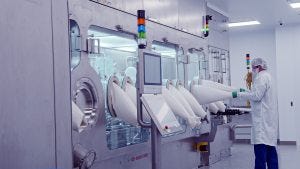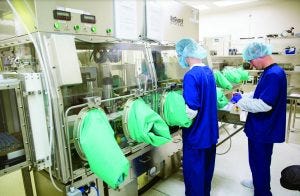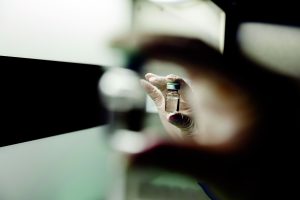Aseptic Considerations in Formulation, Fill and Finish: Choosing Between Barrier and Isolator TechnologiesAseptic Considerations in Formulation, Fill and Finish: Choosing Between Barrier and Isolator Technologies
September 30, 2021

Restricted-access technology is used at Grand River Aseptic Manufacturing’s large-scale fill–finish site in Grand Rapids, MI. It was awarded the 2021 Facility of the Year award for operational agility related to COVID-19 by the International Society for Pharmaceutical Engineering (ISPE). grand river aseptic manufacturing (https://www.grandriverasepticmfg.com)
Biological drug substances are constituent in a wide range of medicinal products with an even broader spectrum of applications. Those include autoimmune-disease treatments (e.g., for arthritis), vaccines, and recombinant therapeutic proteins (e.g., for cancer treatment). What such products all have in common is that they are manufactured using biotechnology and other cutting-edge technologies. Biologics are not as physically robust as their small-molecule counterparts. Hence, during biomanufacturing processes, these complex molecules present a number of challenges. Some of the typical shared characteristics of biopharmaceuticals include
susceptibility to oxidation
degradation from shearing by mechanical actions such as impeller-based mixing
light sensitivity
molecular instability especially at high concentrations.
During downstream processing, unwanted components are removed from biological culture harvest to obtain a final desired molecule in a pure form. That’s followed by formulation to produce a stable final drug product for patients. In the final liquid formulations, biologics generally are not stable for prolonged periods; therefore, such products often get lyophilized to extend their shelf lives. And most biologics become parenteral drug products because they could not survive the oral route of administration intact. That adds another hurdle by requiring final drug products to be sterile based on regulatory requirements (1–3).
Enter Aseptic Processing
Active biopharmaceutical ingredients are seldom heat resistant, which precludes the use of terminal sterilization, and protein structures usually are not compatible with other sterilization methods such as irradiation. Once filled, a biologic product cannot be sterilized in its final container. Hence, biologics require aseptic processing in which container and closure are sterilized separately first, followed by addition of an aseptically formulated product in a strictly controlled environment. That adds an additional level of complexity to an already involved process, requiring thoroughly trained personnel and specialized facilities with specific equipment. In fact, aseptic processing is one of the most challenging aspects of manufacturing of biological medicinal products, as is well recognized by regulatory bodies such as the European Medicines Agency (EMA) and US Food and Drug Administration (FDA). In a number of guidance documents, both have expressed that terminal sterilization, using a reference condition from national/regional pharmacopoeia, is the method of choice (4–6).
Biopharmaceutical sterility cannot be assured by testing; however, all injectable medicinal products must meet the sterility-test requirements described in chapter 2.6.1 of the European Pharmacopoeia or <71> of the United States Pharmacopeia. Those are regarded as a “gold standard” and represent the only analytical methods available for regulatory authorities to examine a drug-product sample for sterility. Thus, sterility assurance is obtained using a well-designed, validated, and controlled manufacturing process. Application of aseptic techniques is paramount throughout that entire process.
The primary objective of aseptic manufacturing is contamination control. With the complex multistep process of biologic formulation and fill–finish (FFF), significant risks from microbiological contamination can come from diverse sources: e.g., personnel, materials, container closures, equipment, and the manufacturing facility environment. To identify the most critical and/or vulnerable parts within the complex processes of fill and finish, a contamination-control risk assessment is recommended.
Combining quality risk management (QRM) tools such as failure-mode and effects analysis (FMEA) with a process-flow evaluation can make risks apparent across the phases of FFF. This enables a company to review the interdependent feeders of the process (e.g., equipment, utilities, and consumables) each with their own potential sources of contamination. Based on controls already present, an assessment can be made to determine whether those risks are sufficiently under control. Where needed, additional controls can be implemented to reduce risks or increase detectability if contamination occurs. Thus, risk assessments and risk management are a leitmotif throughout the FFF process, demanding of companies an in-depth knowledge about their processes, technologies used, and current concepts in contamination control. Internationally it is well recognized that an effective QRM approach can ensure the high quality of a drug product for patients by providing a proactive means to identify and control potential quality issues during manufacture.
Knowledge about the performance of related processes and systems can be gleaned from historical data and information gathered throughout manufacturing. That allows for identification of design flaws or shortcomings, equipment vulnerabilities, and practices that could pose a contamination risk, followed by proposals for control measures and process improvements that enhance the overall control of contamination. That helps a company assess whether its current process design meets regulatory expectations and identify the most critical or urgent issues to be addressed. Perceived controls and reality do not always align.
For stakeholders and decision makers, the results of these exercises present scientific justification for investments to be made in selected areas and enable creation of structured remediation plans when necessary. Such a plan might include interim control measures to reduce existing risks before longer-term solutions can be implemented. For regulators, this can demonstrate that an organization has cultivated a good understanding of its FFF processes and associated vulnerabilities. The company then can present its remediation plan to address identified vulnerabilities. Such a plan and its identified measures contain both proactive actions to reduce the risk of product contamination and controls to increase the detectability of issues that do arise and could lead to contamination. All the resulting measures, practices, and design aspects together form an organization’s contamination control strategy (CCS).

Operators use a glove box for aseptic processing
at Piramal Pharma Solutions. (https://www.piramalpharmasolutions.com)
Technologies, Equipment, and Costs
The design of a manufacturing environment and equipment in place is an important aspect of a company’s FFF process CCS. The many engineering concepts for FFF facilities depend on what type of product(s) are manufactured and at what scale. It would be an unrealistic expectation to maintain a large-scale aseptic manufacturing facility for a contract manufacturing organization (CMO) that is focused on making materials for its clients’ phase 1 clinical studies. On the other hand, a large biopharmaceutical company would not benefit from niche technologies with limited capacity; it would instead use proven methods and equipment to ensure a robust throughput of products to market.
Regulators encourage the use of restricted access barrier system (RABS) or isolator technologies. Such settings minimize direct human intervention in a process, reducing the risk of microbial ingress from operators. For existing facilities with an aseptic FFF process in place, introducing such technologies is not always an option. That is particularly a concern with aging or “legacy” facilities.
Transition from a classic design based on grade-A or grade-B cleanrooms to an upgraded facility is not to be taken lightly. Such a project would take significant time and effort to retrofit or replace aseptic manufacturing lines — requiring major financial investment. However, because regulatory bodies have increased their expectations regarding aseptic manufacturing and use of available technologies, it might become inevitable that companies will be required to upgrade the most critical areas of their aseptic FFF facilities. The main difference between isolator and RABS technologies — each offering its own advantages and limitations — is that isolators have automated biodecontamination cycles. A company’s choice of technology depends on several factors related to cost, cleaning, and operations.
RABS: An existing setting can be upgraded by retrofitting the fill line to an open RABS. Operating a grade-A RABS with a grade-B background provides flexibility to a process and can be relatively cost efficient because it maintains use of existing equipment. Running costs of conventional cleanrooms are well defined, but costs for heating, ventilation, and air conditioning (HVAC) systems can be substantial. Manufacturers also must account for general engineering maintenance and electricity as well as a cleaning/disinfection regime to maintain a cleanroom classification. In addition to the cost for disinfectants and consumables, that also includes the cost of labor. Accessibility of equipment and the required footprint of such settings are other aspects to consider.
Another cost to account for covers both planned and unplanned downtime and costs associated with grade-B maintenance and requalification. This includes high-energy particulate air (HEPA) filter recertification and air-particle classification following the ISO-14644 standard. The same applies for grade-A RABS as well, which would have to be included in a site’s general maintenance schedule. As part of aseptic activities, a unit must be disinfected and its gloving periodically tested for integrity. For that, equipment and consumables are required that figure into the overall costs of the FFF operation along with associated operator time.
When performing manufacturing activities in grade A or B settings, operators/technicians must be gowned in accordance with the room classification. The quality and type of garments should be appropriate for the process and the grade of the working area. Clean and sterile dedicated cleanroom gowning is required for each working session, which contribute significantly to the overall cost. Operators must demonstrate their ability in good garbing practices and cleanroom behavior — skills that are maintained through operator (re)qualification programs. Gowning itself adds to the overall preparation time for operators, thus indirectly affecting the overall cost of manufacturing.

On the Cover: Roche technicians examine final products. (https://www.roche.com)
Isolators: Overall running costs associated with preparation of an aseptic environment and background can be reduced by the use of isolator technology. Isolators provide the best protection for operators and a high sterility assurance for products by removing operators from the isolated environment. Exposure of sterilized components and products occurs only within a sealed and decontaminated unit, which greatly enhances contamination control. Decontamination of interior surfaces is achieved mostly through validated hydrogen-peroxide (H2O2) vapor cycles, which require periodic requalification. These fully isolated systems provide total containment for all material handling, with their high capital outlay offset by lowered operating costs.
Isolator technology represents a significant investment. Besides the initial costs of an isolator unit and ancillary equipment, companies must take into count related costs for installation, qualification, and validation. Installation and operation qualification (IOQ) often can be performed by an isolator vendor. Decontamination cycle development requires specialist knowledge and can be time consuming. Other considerations include temperature-mapping and smoke-visualization/distribution studies using chemical indicators (CIs) in vapor form.
As part of the isolator qualification, a biological indicator (BI) challenge helps demonstrate that the decontamination study can achieve a predefined reduction of, e.g., Geobacillus stearothermophilus spores. BI locations within an isolator unit are based on a risk assessment to identify positions that will be most difficult to decontaminate. Data from the temperature, relative-humidity, air-visualization, and CI studies are used to support those selected locations.
Requalification of the decontamination process is an annual requirement. Companies also must demonstrate that product quality will not be affected adversely as a result of potential H2O2 vapor residues present in the isolator. Such testing is similar to that for assessing the recovery of microorganisms from media used in environmental monitoring. Like any other aseptic manufacturing area, an isolator’s interior must be monitored to demonstrate compliance with grade-A and/or ISO-5 levels for microbial and particulate contamination. Sampling equipment such as viable-air samples and laser particle counters are to be integrated in an isolator’s design, so related costs also need to be factored into those of the overall equipment. The equipment also requires maintenance and recalibration at regular intervals. Isolator gloves should be tested mechanically for integrity before and after each batch or campaign, and a glove-management program must be in place and scientifically justified.
Isolators for FFF processes require installation in an area with at least a grade-D classification. The running costs of such areas are considerably lower than those for maintaining a grade-B cleanroom environment, as are requalification frequencies. This alleviates the overall costs to some extent. Operators need not wear sterile garments to work with isolators, and although aseptic practices remain paramount inside the isolated environment, no periodic gowning recertification is required.
Despite the longer term financial benefits and high-level of contamination control it provides, note that using isolator technology can decrease flexibility in manufacturing processes. Once an isolator is set up and its decontamination cycle is running, no changes can be made to its configuration without aborting the process and initiating a restart. Specific knowledge is required for implementing and maintaining such technology — expertise that isn’t always present at companies seeking to upgrade their FFF processes.
Driving the Decision: What option is preferred and suitable for a given company? RABS settings and isolator environments should be evaluated case by case, with consideration to the advantages and disadvantages of each option. In addition to scientific justification and regulatory expectations, the concerns of a company’s chief financial officer (CFO) most likely will play a significant role in this decision-making process.
References
1 Annex 1: Manufacture of Sterile Medicinal Products (revised). EudraLex Volume 4. European Commission: Brussels, Belgium, 25 November 2008; https://ec.europa.eu/health/sites/default/files/files/eudralex/vol-4/2008_11_25_gmp-an1_en.pdf.
2 Gomez-Broughton C. Aseptic Processing of Biological Products: Current Regulatory Issues — “Facing the Challenges of Drug Product Manufacturing.” US Food and Drug Administration: Rockville, MD, 2021; https://www.fda.gov/media/103517/download.
3 CBER/CDER/ORA. Guidance for Industry: Sterile Drug Products Produced By Aseptic Processing — Current Good Manufacturing Practice. US Food and Drug Administration: Rockville, MD, September 2004; https://www.fda.gov/media/71026/download.
4 EMA/CHMP/CVMP/QWP/850374/2015. Guideline on the Sterilisation of the Medicinal Product, Active Substance, Excipient and Primary Container. European Medicines Agency: London, UK, 6 March 2019; https://www.ema.europa.eu/en/documents/scientific-guideline/guideline-sterilisation-medicinal-product-active-substance-excipient-primary-container_en.pdf.
5 Annex 2: Manufacture of Biological Active Substances and Medicinal Products for Human Use. EudraLex Volume 4. European Commission: Brussels, Belgium, 28 June 2018; https://ec.europa.eu/health/sites/default/files/files/eudralex/vol-4/pdfs-en/2018_annex2_en.pdf.
6 Part 211.113, Subpart F: Production and Process Controls (revised). Code of Fed. Reg. Title 21. US Food and Drug Administration: Rockville, MD, 1 April 2020; https://www.accessdata.fda.gov/scripts/cdrh/cfdocs/cfCFR/CFRSearch.cfm?fr=211.113.
Further Reading
Blanchard MM. Ensuring Aseptic Processing Through Quality By Design. BioProcess Int. 10(2) 2012: 52–55; https://bioprocessintl.com/manufacturing/facility-design-engineering/ensuring-aseptic-processing-through-quality-by-design-326671.
Hull BJ. Critical Considerations for Fill–Finish Manufacturing: Demand to Increase Speed and Flexibility While Maintaining Sterility Spurs Adoption of Novel Technologies. BioProcess Int. 17(6) 2019: 54–57; https://bioprocessintl.com/sponsored-content/critical-considerations-for-fill-finish-manufacturing-demand-to-increase-speed-and-flexibility-while-maintaining-sterility-spurs-adoption-of-novel-technologies.
Scott C, Gazaille B. eBook: Formulation, Fill–Finish — Biopharmaceutical Drug-Product Trends and Technologies. BioProcess Int. eBook January 2021: https://bioprocessintl.com/manufacturing/fill-finish/ebook-formulation-fill-finish-biopharmaceutical-drug-product-manufacturing-trends-and-technologies.
Patrick Nieuwenhuizen is a consultant and senior manager at PharmaLex Ireland, suite 2, Stafford House, Strand Road, Portmarnock, County Dublin D13 H525, Ireland; [email protected].
You May Also Like





